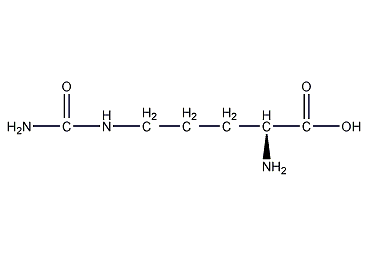
Structural formula
| Business number | 04JE |
|---|---|
| Molecular formula | C6H13N3O3 |
| Molecular weight | 175.19 |
| label |
(S)-2-Amino-5-ureidopentanoic acid, carbamoylornithine, (S)-2-Amino-5-ureidopentanoic acid, a-Amino- δ-uridovaleric acid, L-Citrulline, Alicyclic compounds, amino acids, intermediates, Biochemical reagents |
Numbering system
CAS number:372-75-8
MDL number:MFCD00064397
EINECS number:206-759-6
RTECS number:None
BRN number:1725416
PubChem number:24892975
Physical property data
1. Properties: white crystal. Bitter taste.
2. Solubility: soluble in water, insoluble in methanol and ethanol
3. Melting point (ºC) 222
4. Relative density (d204) :1.289
Toxicological data
2. Toxicological data:
Acute toxicity: Not available.
Ecological data
3. Ecological data:
1. Other harmful effects: This substance may be harmful to the environment, and special attention should be paid to water bodies.
Molecular structure data
1. Molar refractive index: 42.06
2. Molar volume (cm3/mol): 135.8
3. Isotonic specific volume (90.2K ): 381.1
4. Surface tension (dyne/cm): 61.9
5. Polarizability (10-24cm3): 16.67
Compute chemical data
1. Reference value for hydrophobic parameter calculation (XlogP): None
2. Number of hydrogen bond donors: 4
3. Number of hydrogen bond acceptors: 4
4. Number of rotatable chemical bonds: 5
5. Number of tautomers: 3
6. Topological molecule polar surface area 118
7. Number of heavy atoms: 12
8. Surface charge: 0
9. Complexity: 171
10. Number of isotope atoms: 0
11. Determine the number of atomic stereocenters: 1
12. Uncertain number of atomic stereocenters: 0
13. Determine the number of chemical bond stereocenters: 0
14. Number of uncertain chemical bond stereocenters: 0
15. Number of covalent bond units: 1
Properties and stability
1. Citrulline is the same as ornithine. It only exists in the liver and is not a component of protein. It is an important intermediate in the human body’s urea cycle.
2. Found in tobacco leaves.
Storage method
Stored in a cool, dry place and sealed.
Synthesis method��
1. An amino acid isolated from watermelon juice for the first time. Obtained from alkaline hydrolysis of arginine.
Purpose
Amino acid drugs. Can be used in combination with ornithine, arginine, etc. to treat hyperammonemia

 微信扫一扫打赏
微信扫一扫打赏

